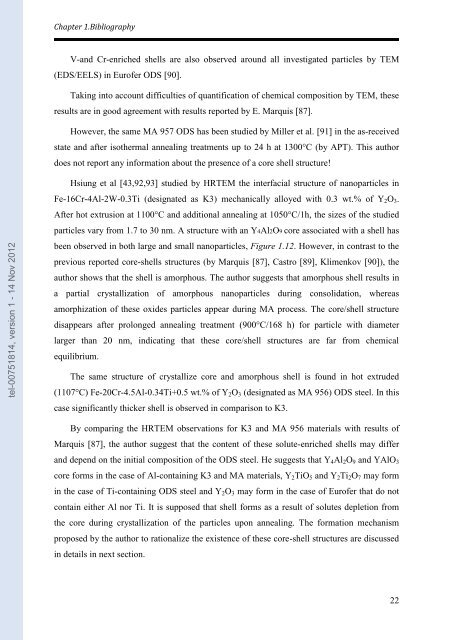Etude par Sonde Atomique Tomographique de la formation de nano ...
Etude par Sonde Atomique Tomographique de la formation de nano ...
Etude par Sonde Atomique Tomographique de la formation de nano ...
You also want an ePaper? Increase the reach of your titles
YUMPU automatically turns print PDFs into web optimized ePapers that Google loves.
tel-00751814, version 1 - 14 Nov 2012<br />
Chapter 1.Bibliography<br />
V-and Cr-enriched shells are also observed around all investigated <strong>par</strong>ticles by TEM<br />
(EDS/EELS) in Eurofer ODS [90].<br />
Taking into account difficulties of quantification of chemical composition by TEM, these<br />
results are in good agreement with results reported by E. Marquis [87].<br />
However, the same MA 957 ODS has been studied by Miller et al. [91] in the as-received<br />
state and after isothermal annealing treatments up to 24 h at 1300°C (by APT). This author<br />
does not report any in<strong>formation</strong> about the presence of a core shell structure!<br />
Hsiung et al [43,92,93] studied by HRTEM the interfacial structure of <strong>nano</strong><strong>par</strong>ticles in<br />
Fe-16Cr-4Al-2W-0.3Ti (<strong>de</strong>signated as K3) mechanically alloyed with 0.3 wt.% of Y2O3.<br />
After hot extrusion at 1100°C and additional annealing at 1050°C/1h, the sizes of the studied<br />
<strong>par</strong>ticles vary from 1.7 to 30 nm. A structure with an Y4Al2O9 core associated with a shell has<br />
been observed in both <strong>la</strong>rge and small <strong>nano</strong><strong>par</strong>ticles, Figure 1.12. However, in contrast to the<br />
previous reported core-shells structures (by Marquis [87], Castro [89], Klimenkov [90]), the<br />
author shows that the shell is amorphous. The author suggests that amorphous shell results in<br />
a <strong>par</strong>tial crystallization of amorphous <strong>nano</strong><strong>par</strong>ticles during consolidation, whereas<br />
amorphization of these oxi<strong>de</strong>s <strong>par</strong>ticles appear during MA process. The core/shell structure<br />
disappears after prolonged annealing treatment (900°C/168 h) for <strong>par</strong>ticle with diameter<br />
<strong>la</strong>rger than 20 nm, indicating that these core/shell structures are far from chemical<br />
equilibrium.<br />
The same structure of crystallize core and amorphous shell is found in hot extru<strong>de</strong>d<br />
(1107°C) Fe-20Cr-4.5Al-0.34Ti+0.5 wt.% of Y2O3 (<strong>de</strong>signated as MA 956) ODS steel. In this<br />
case significantly thicker shell is observed in com<strong>par</strong>ison to K3.<br />
By com<strong>par</strong>ing the HRTEM observations for K3 and MA 956 materials with results of<br />
Marquis [87], the author suggest that the content of these solute-enriched shells may differ<br />
and <strong>de</strong>pend on the initial composition of the ODS steel. He suggests that Y4Al2O9 and YAlO3<br />
core forms in the case of Al-containing K3 and MA materials, Y2TiO5 and Y2Ti2O7 may form<br />
in the case of Ti-containing ODS steel and Y2O3 may form in the case of Eurofer that do not<br />
contain either Al nor Ti. It is supposed that shell forms as a result of solutes <strong>de</strong>pletion from<br />
the core during crystallization of the <strong>par</strong>ticles upon annealing. The <strong>formation</strong> mechanism<br />
proposed by the author to rationalize the existence of these core-shell structures are discussed<br />
in <strong>de</strong>tails in next section.<br />
22

















